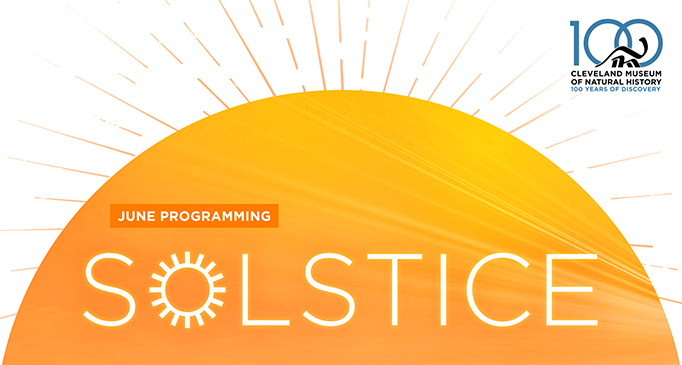/Balto_Birthday_Bash_Announcement_682x384.jpg)
/Balto_Birthday_Bash_Announcement_682x384.jpg)


Longer days have arrived in the Northern Hemisphere, which means there’s even more time for summer fun! The Cleveland Museum of Natural History is pleased to present its Summer Solstice Celebration as part of its exciting lineup of centennial programming. Whether you’re taking a staycation or looking for safe summer outings, the Museum has the perfect event for you.
Join the Museum online for a special DiscoverE program on Thursday, June 10, at 7pm, when Museum naturalist Garrett Ormiston will welcome leading forest ecologist Dr. Suzanne Simard for a discussion of her new book, Finding the Mother Tree. Dr. Simard will present her research arguing that trees not only provide timber and pulp, but also form a complicated, interdependent circle of life. After their conversation, the speakers will open the floor to questions from the audience. This event may just transform your view of trees and how they interact in a forest.
This June, the Museum will also debut the special Centennial Soirée Series. On Friday, June 18, enjoy exquisite dinner and wine pairings in the Museum’s newly redesigned courtyard (weather permitting) while exploring astronomy under the stars. As the series continues, join Museum experts on September 24, 2021, January 21, 2022, and April 29, 2022, to learn more about nature’s wonders over dinner and wine. Mark your calendars for this don’t-miss series and stay connected to the Museum for further details.
On Sunday, June 20, at 9am, practice Sun salutations during Summer Solstice Yoga in the Museum’s courtyard (weather permitting). You’ll enjoy 45 minutes of professional yoga instruction, courtesy of Cleveland Yoga Little Italy, and receive a complimentary mimosa and fresh fruit, parking, and general-admission access to the Museum for the rest of the day. Then, extend the Zen during Downward Dog with Dinos, the Museum’s summer yoga series that will take place every Sunday through the end of September.
On Sunday, June 6, Museum naturalists will offer two in-person hikes exploring the diverse habitats of Blue Heron Farm—the Museum’s newest addition to its natural areas portfolio. The preserve features ledges, caves, a scenic stretch of the east branch of the Cuyahoga River, and upland and wetland forests. For even more solstice fun, immerse yourself in the sights and sounds of the nocturnal forest at the Museum's Windsor Woods Preserve on Friday, June 18, at 8pm.
In June, the Museum will also expand its hours of operation to be open Tuesday through Sunday, 10am to 5pm. Make the most of those extra hours of sunshine with the Museum’s series of solstice events this June.
Calendar of Events
Instructors: Garrett Ormiston & Ken Schneider
Date: Sunday, June 6
Time: 10am & 3pm
Date: Thursday, June 10
Time: 7pm EST
Presenters: Jason Davis, Peter Hedman, and Nick Anderson
Date: Friday, June 18
Time: 6:30pm EST
Instructors: Garrett Ormiston & Ken Schneider
Date: Friday, June 18
Time: 8pm
Instructor: Julie DiBiasio
Date: Sunday, June 20
Time: 9am
ABOUT SUMMER SOLSTICE
Summer solstice is the time when the Earth’s Northern Hemisphere is tilted closest to the Sun. In our region, the solstice marks the arrival of later sunsets and warmer temperatures. Since the hours of daylight increase as one moves from the equator toward the North Pole, the effects on daylight are amplified as one moves farther north.
Areas close to the Arctic Circle (such as the state of Alaska and the Earth’s northernmost nations, including Russia, Norway, and Finland) will see varying lengths of daylight depending on how far they are from the equator. At the North Pole itself, the Sun will not set at all between late March and late September. A phenomenon known as the midnight sun, during which the Sun does not dip below the horizon before midnight local time, will also occur.
Those in the Southern Hemisphere will experience the opposite, celebrating their winter solstice when we arrive at our summer solstice. Areas south of the equator will see shorter days and cooler temperatures, and Earth’s southern tip will not see daylight for several months.
Many cultures attach significance to the arrival of the solstice and celebrate the occasion in special ways. Perhaps the best-known event is Midsummer, which marks the halfway point in the growing season. Midsummer is celebrated by various cultures around the world with dancing, singing, and feasts.
In 2014, the United Nations General Assembly also declared the June solstice the International Day of Yoga, noting the importance of “harmony between man and nature.” The Museum is similarly committed to deepening appreciation for the interconnectedness of life on Earth. Don’t miss your chance to celebrate the longest days of summer with special centennial programming from the Cleveland Museum of Natural History.